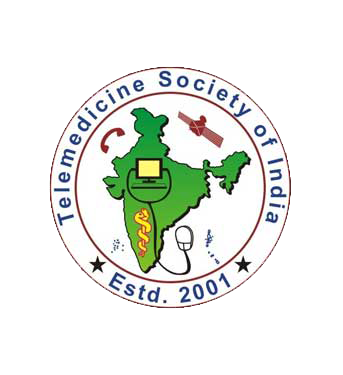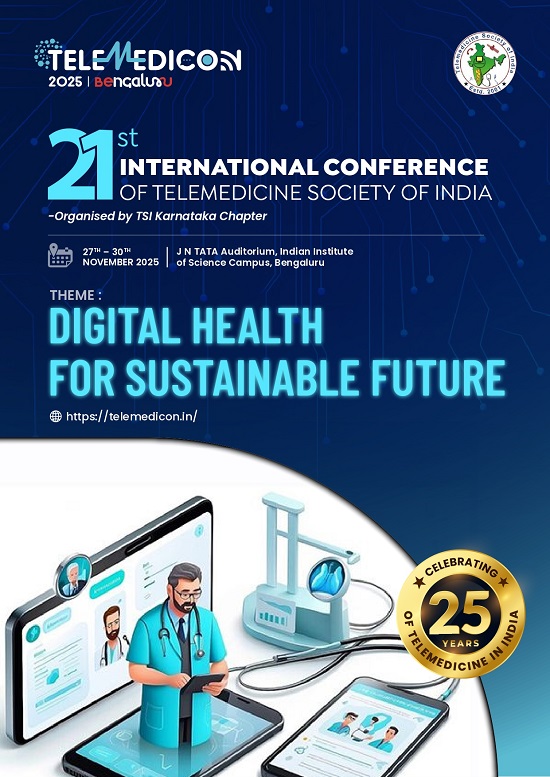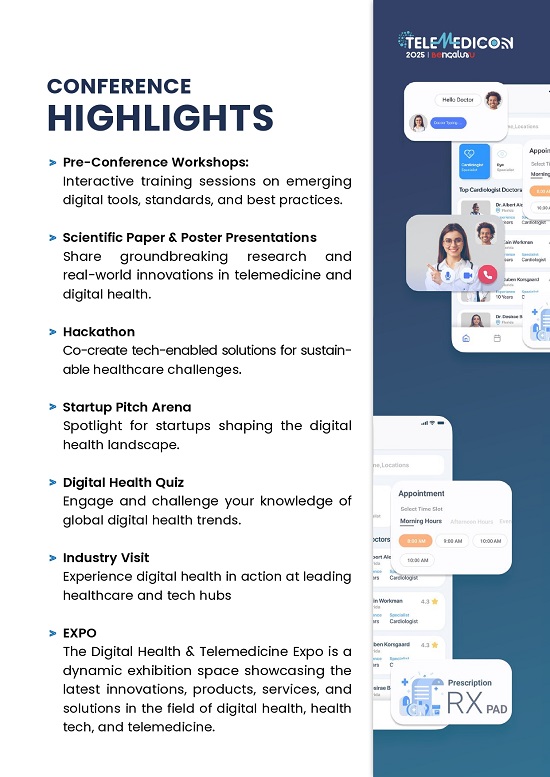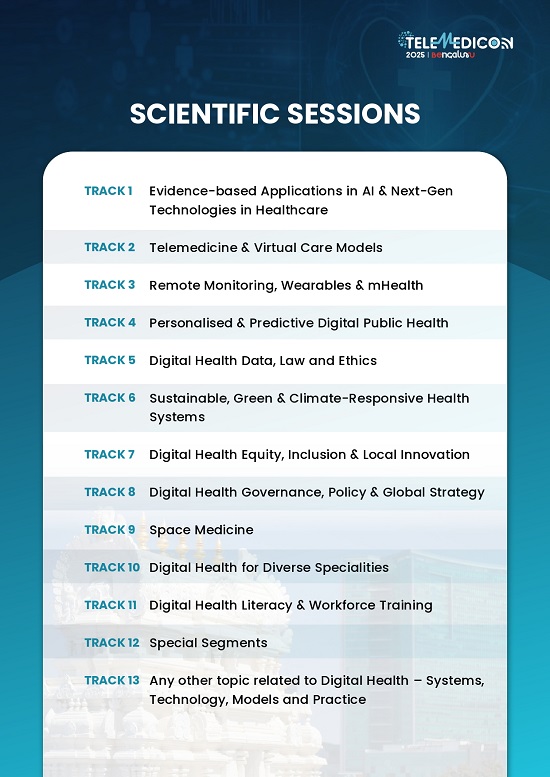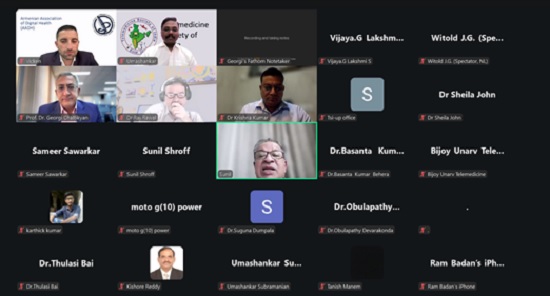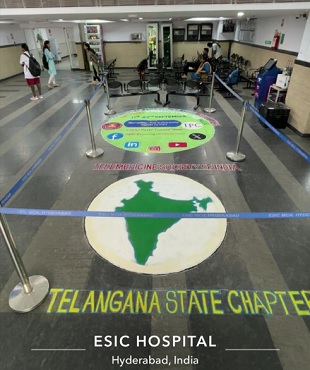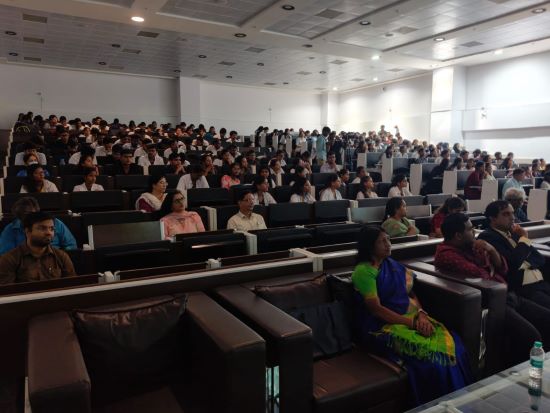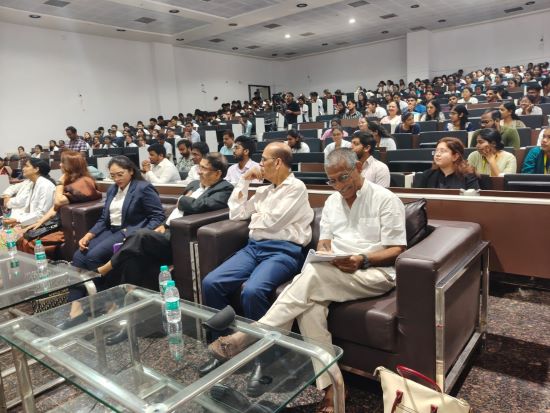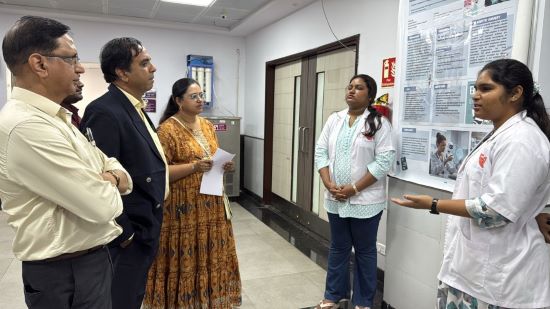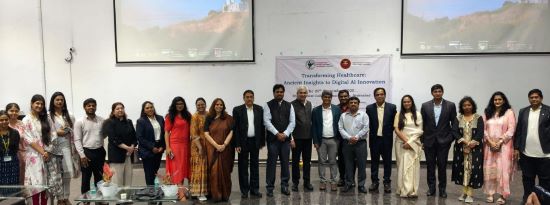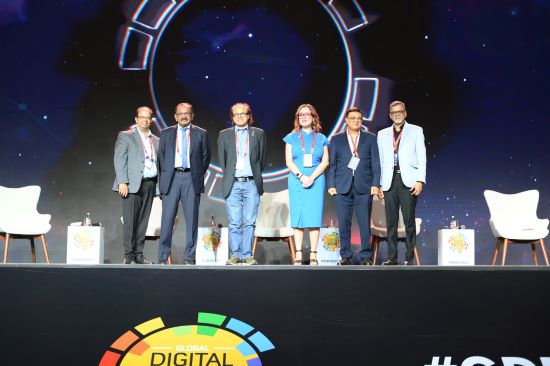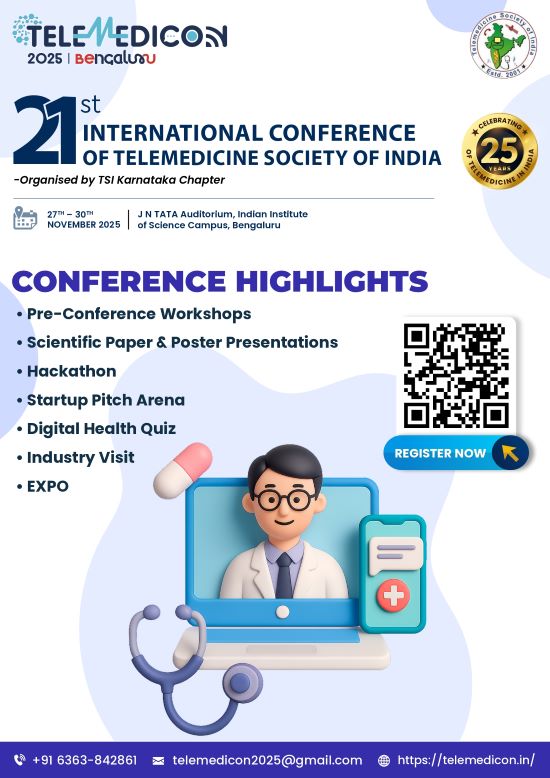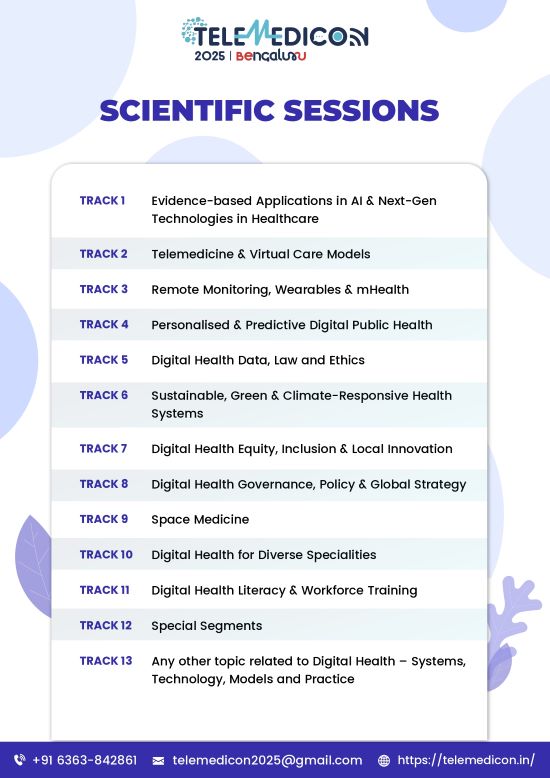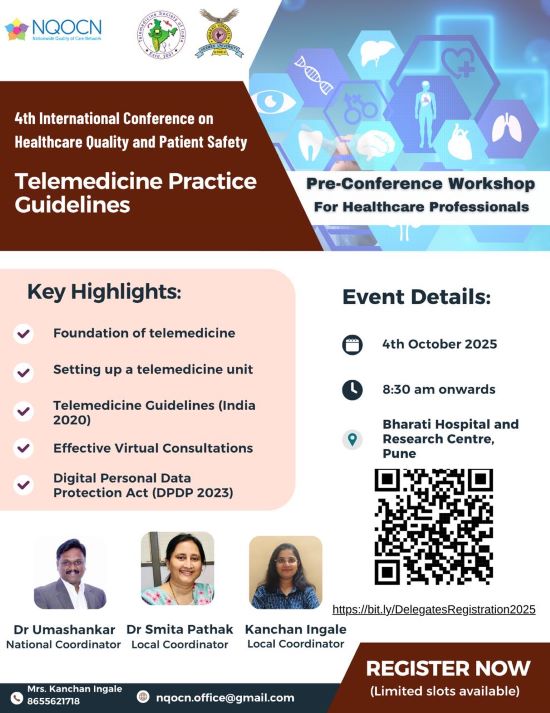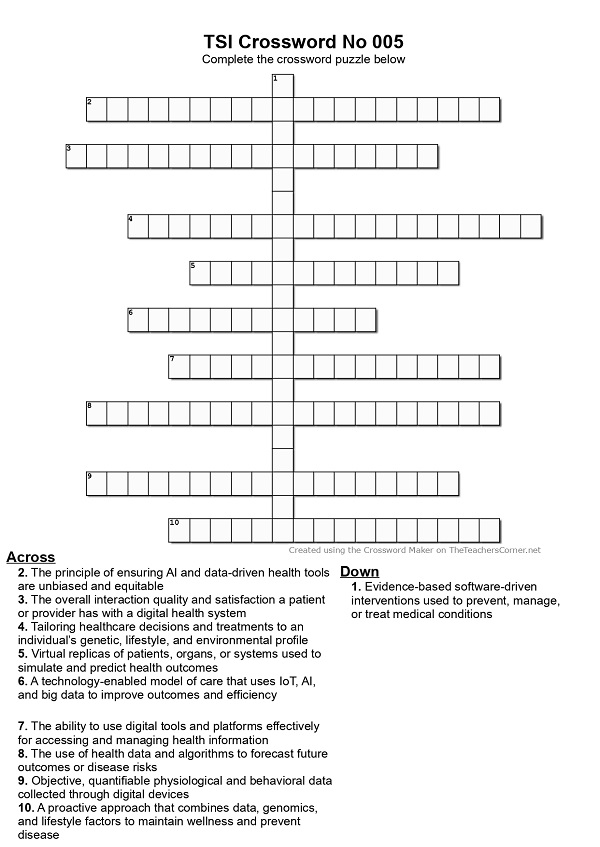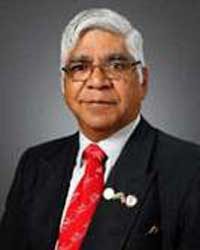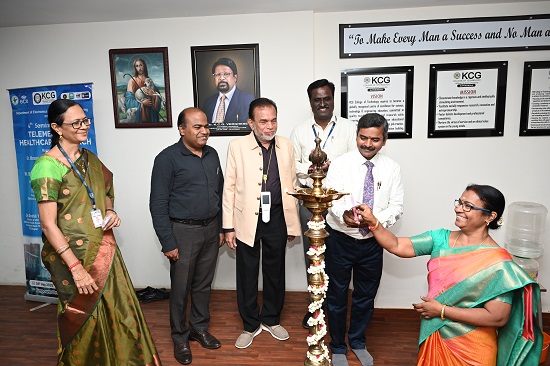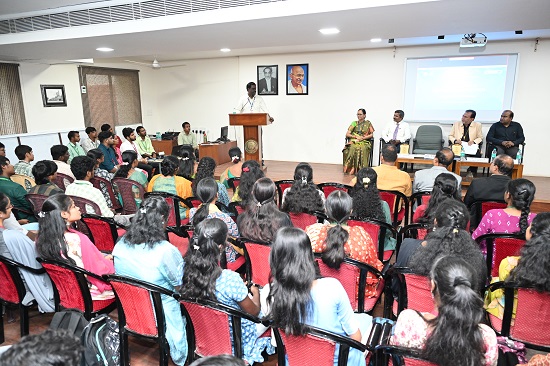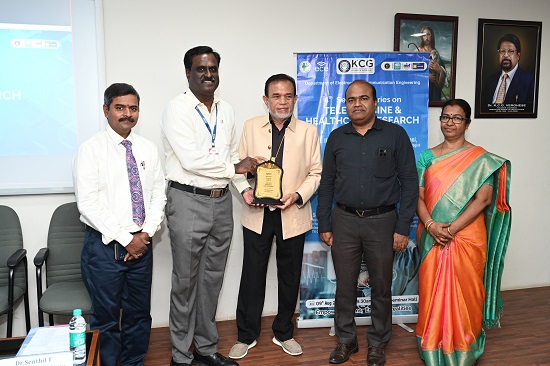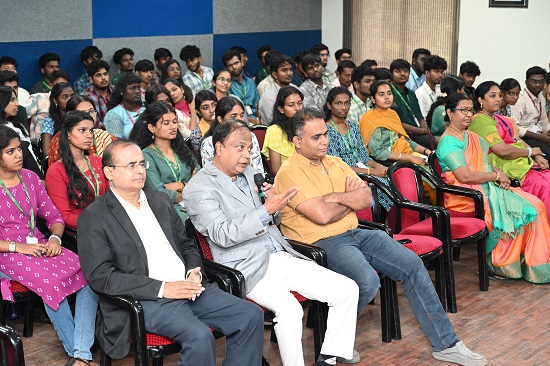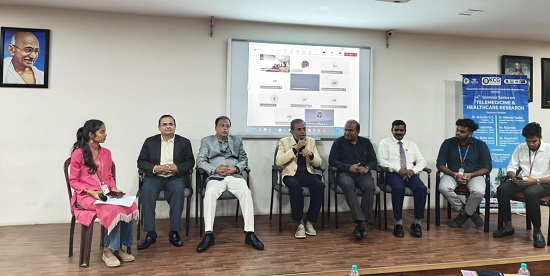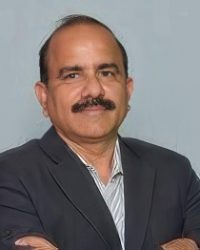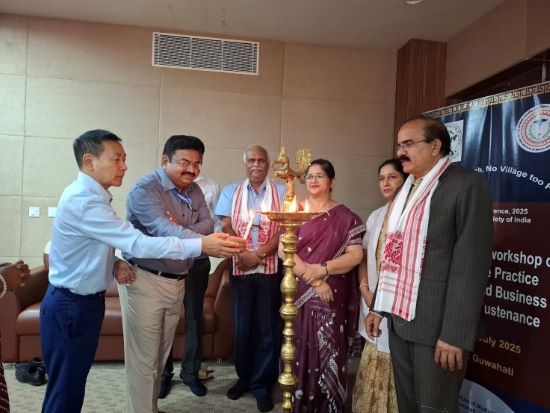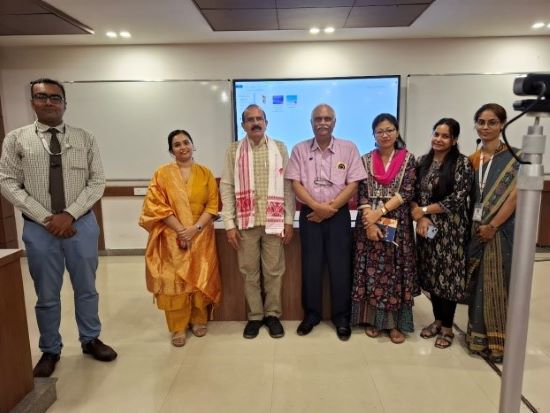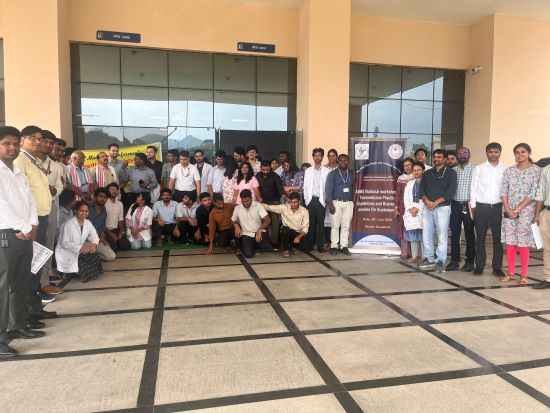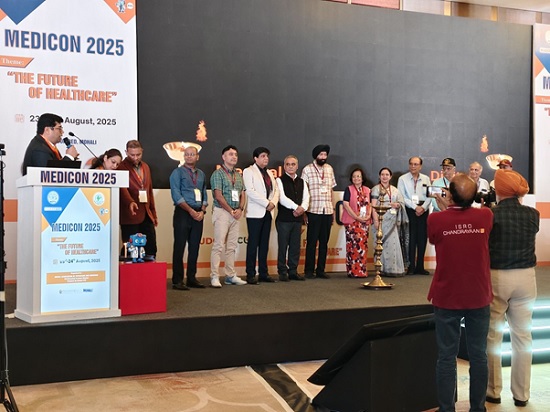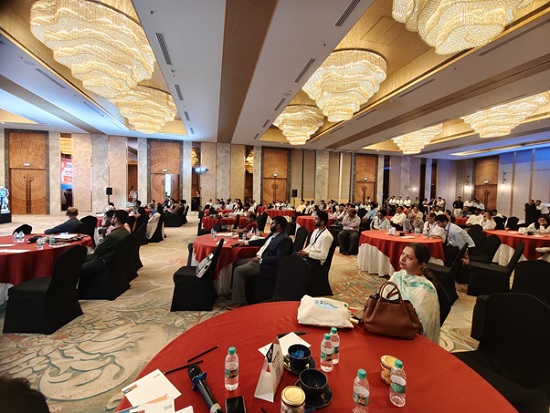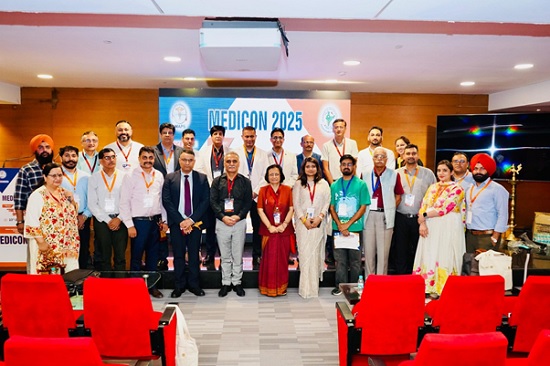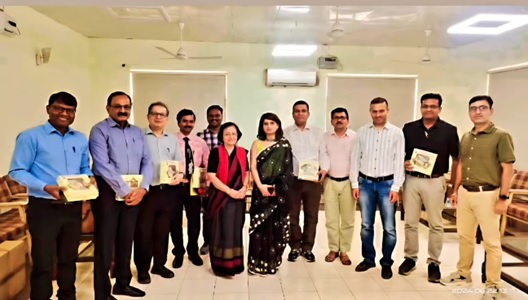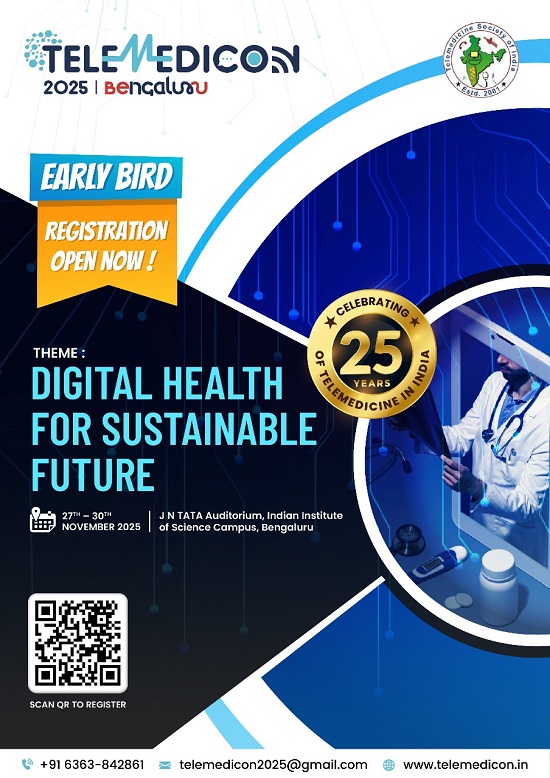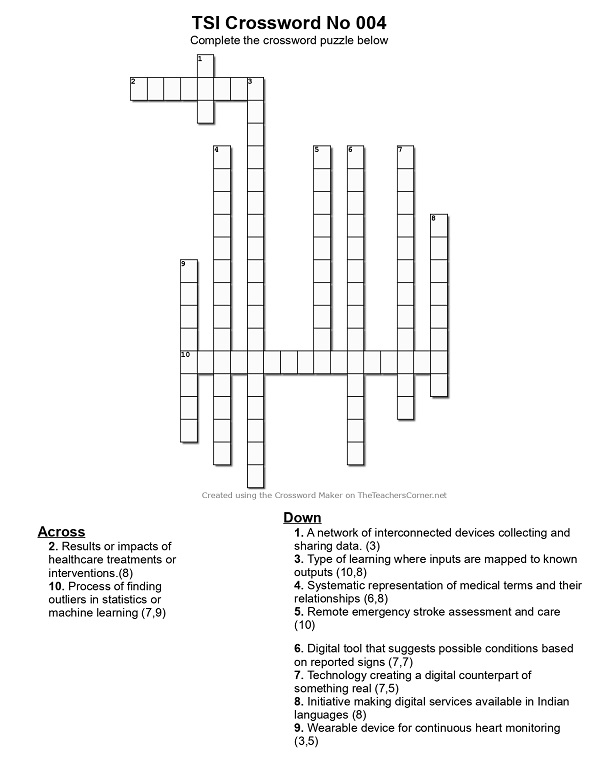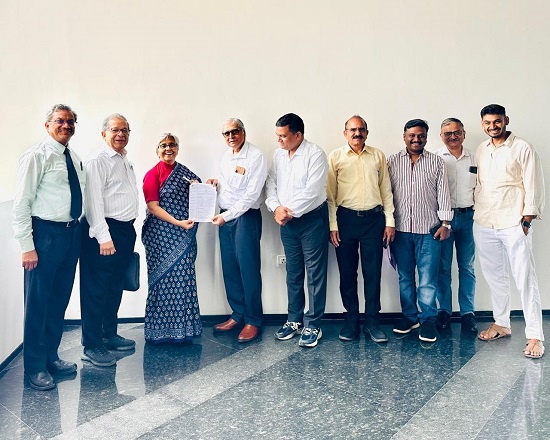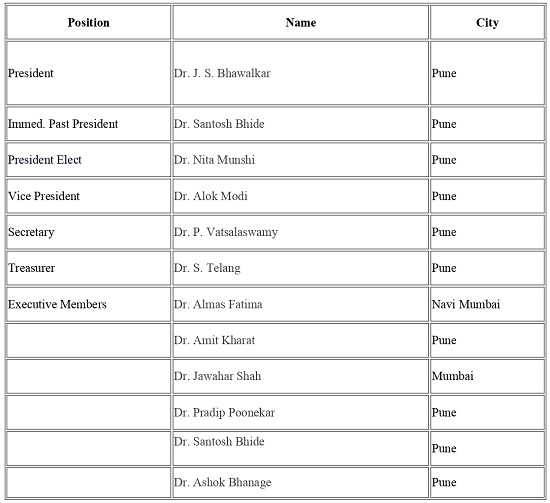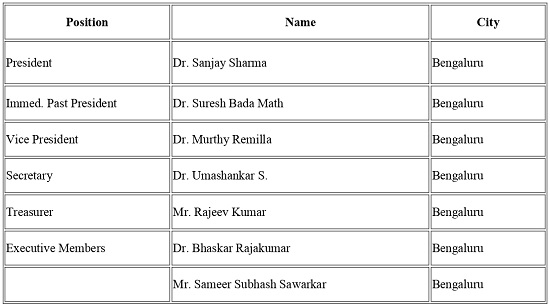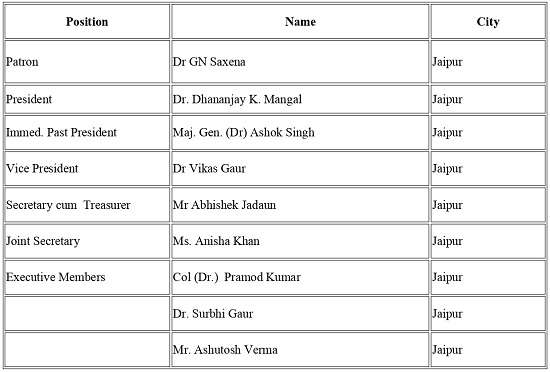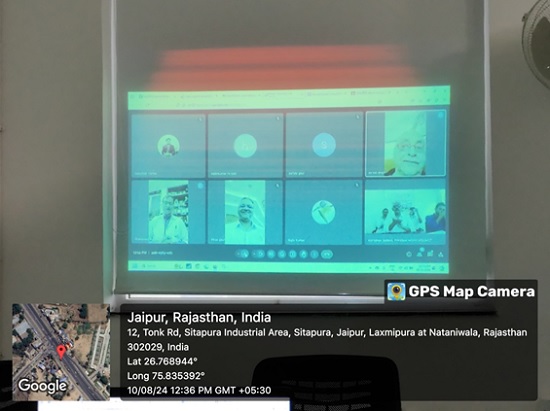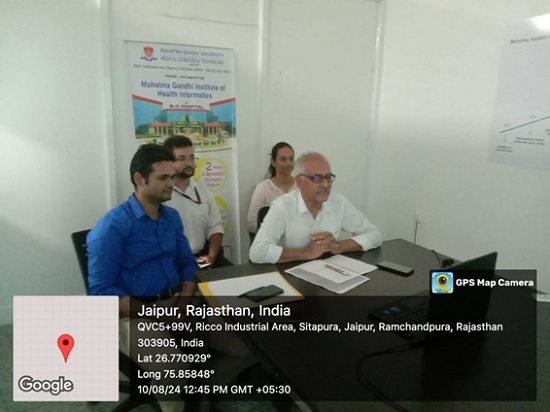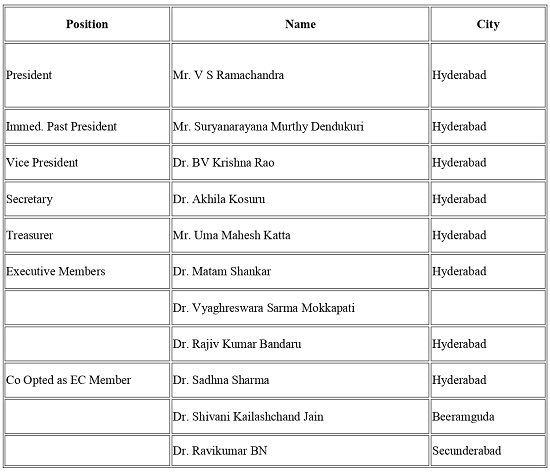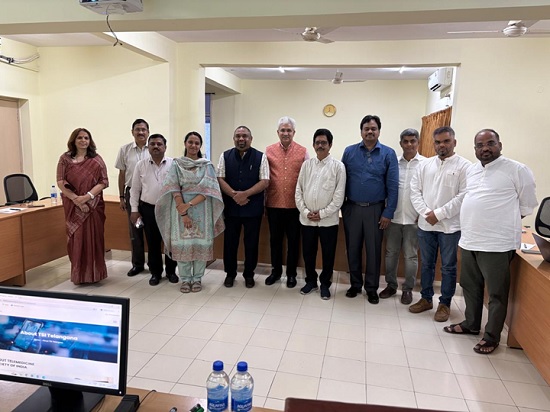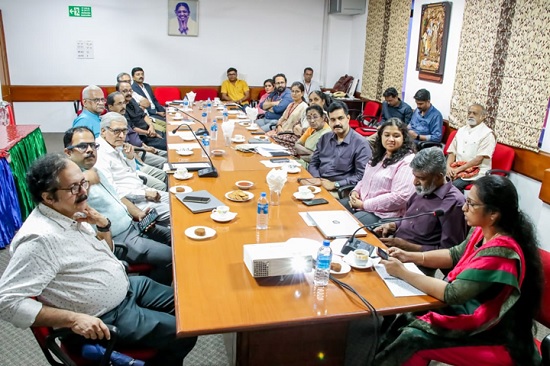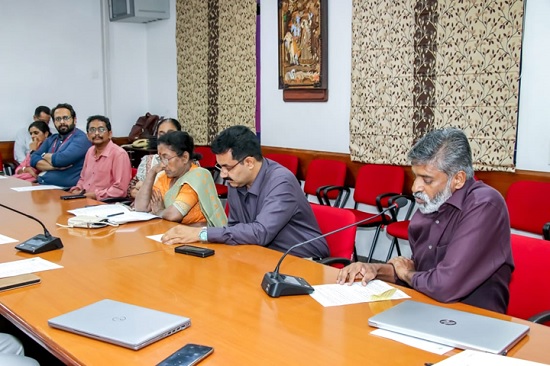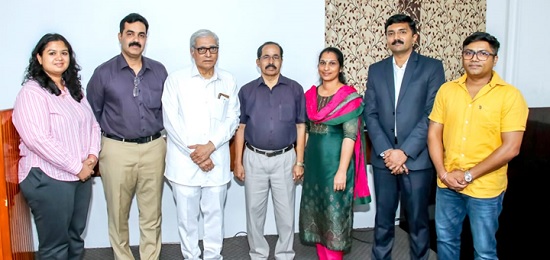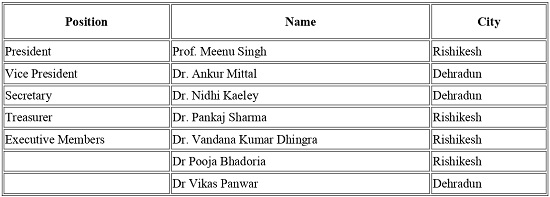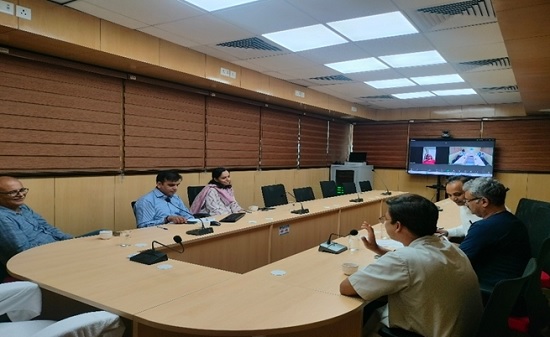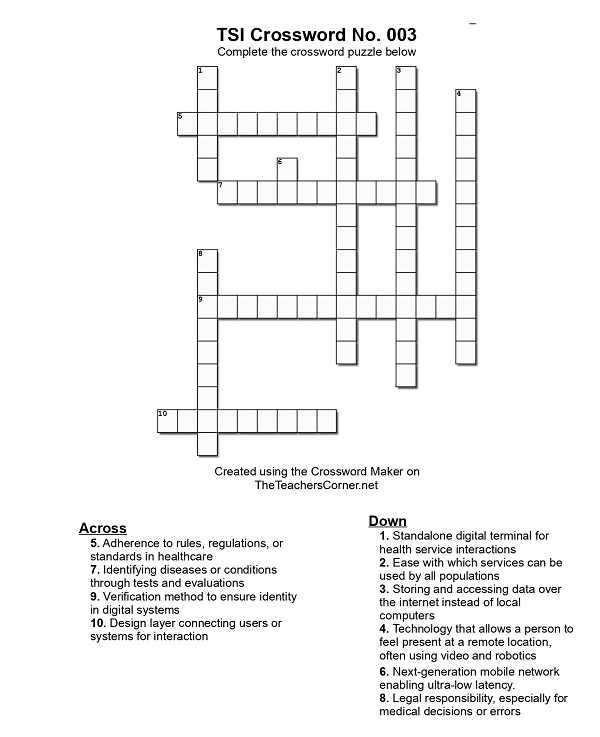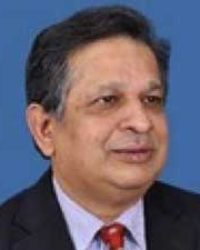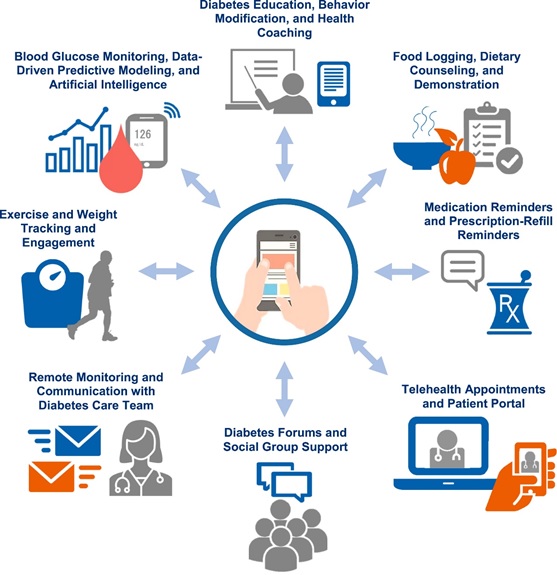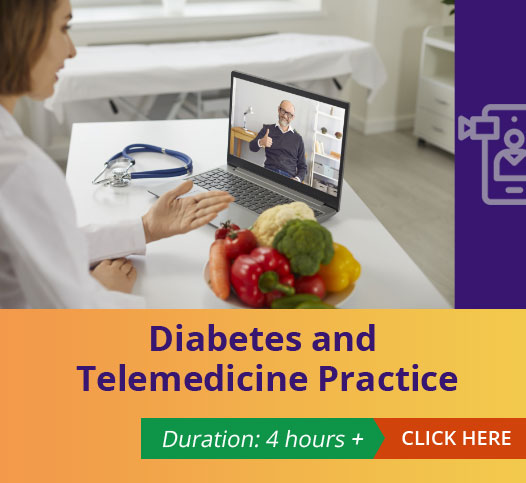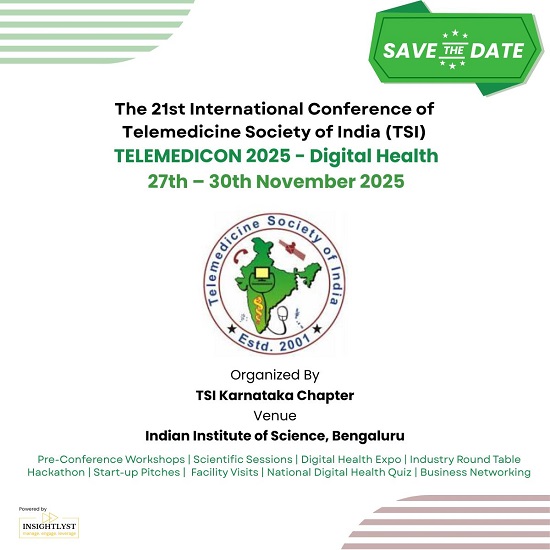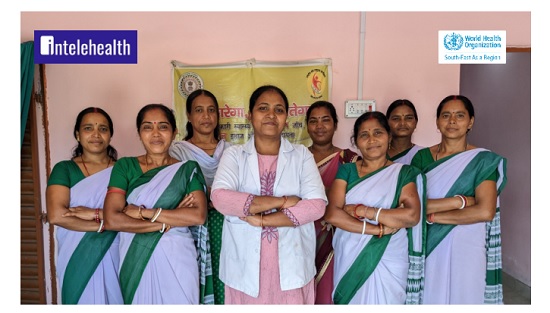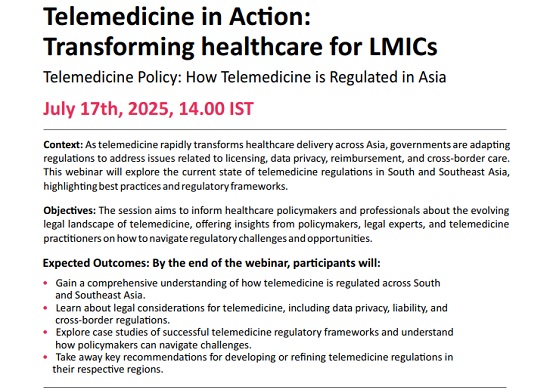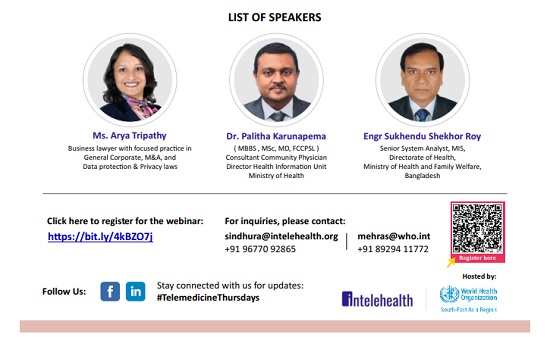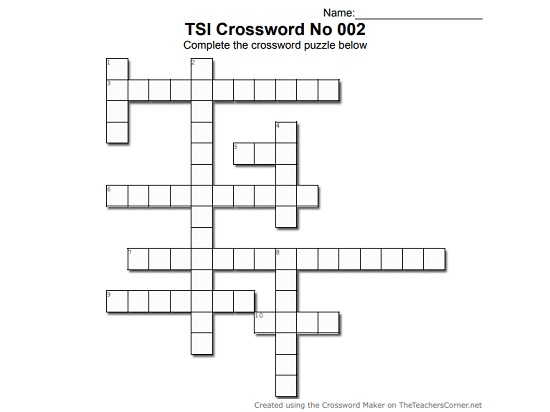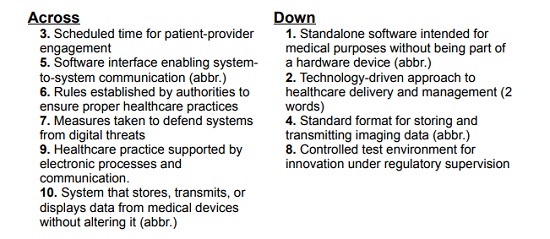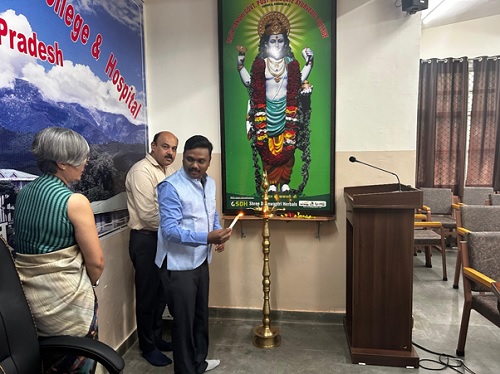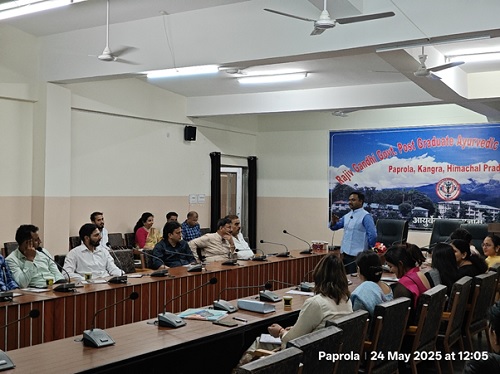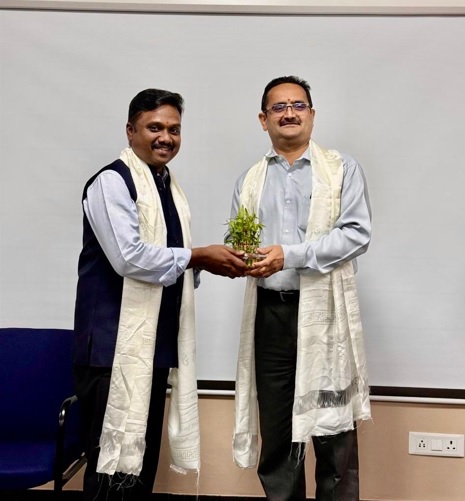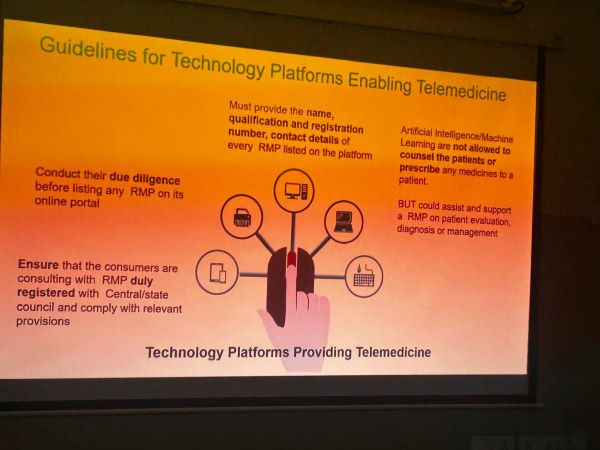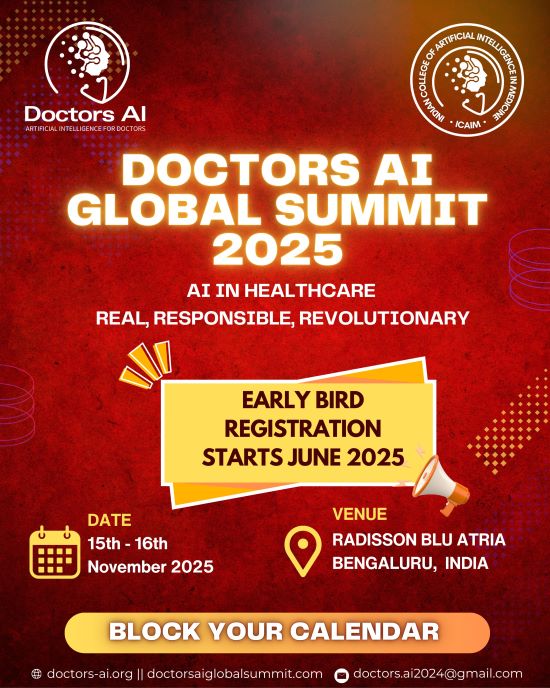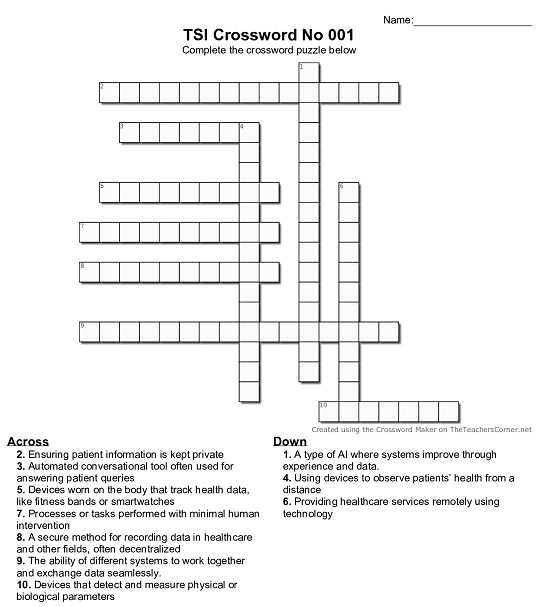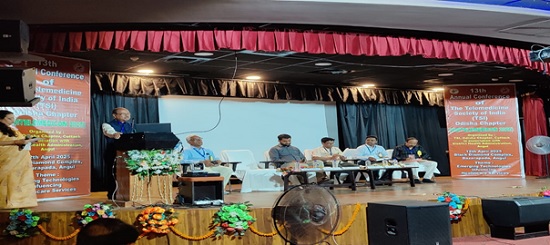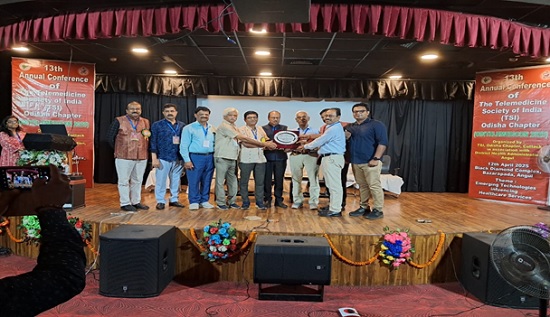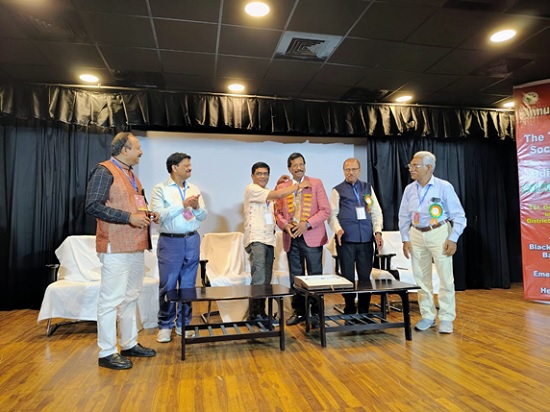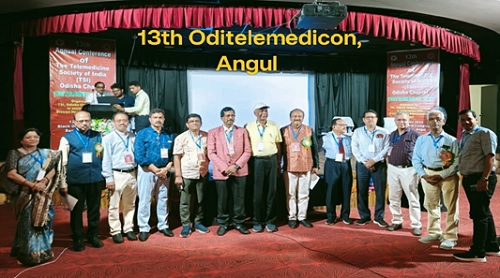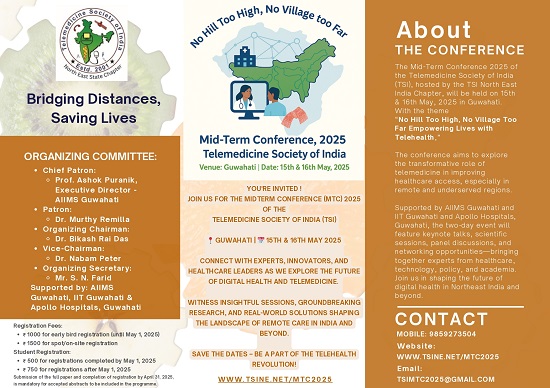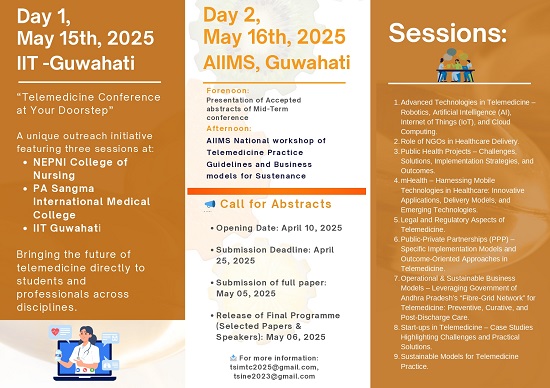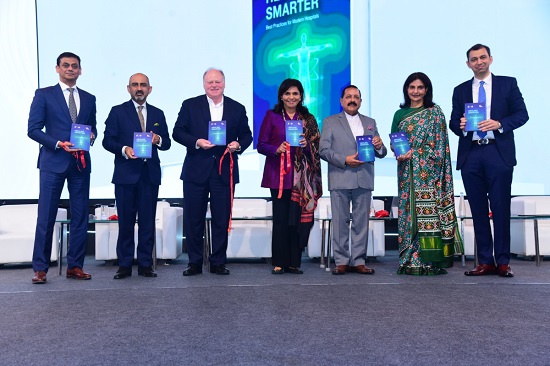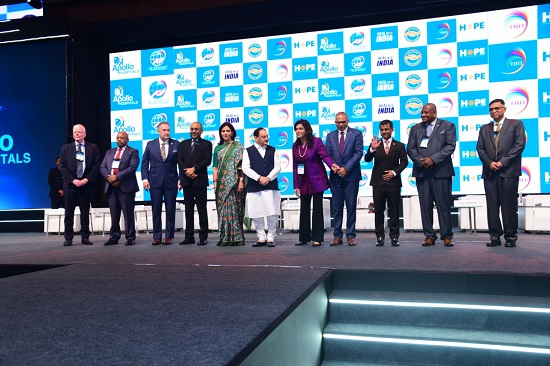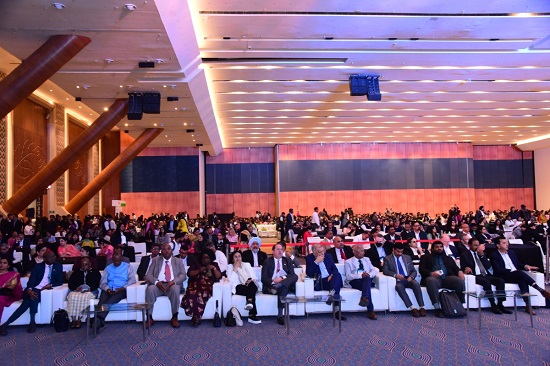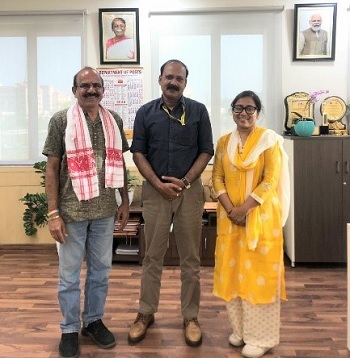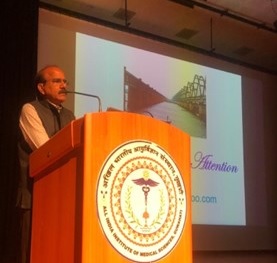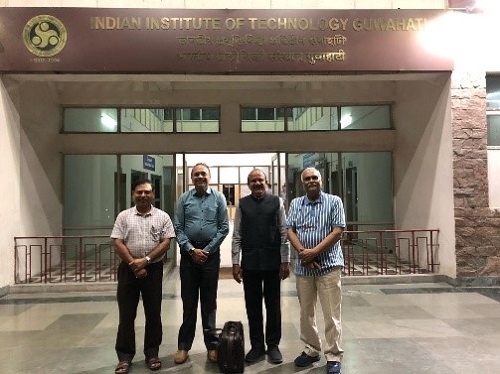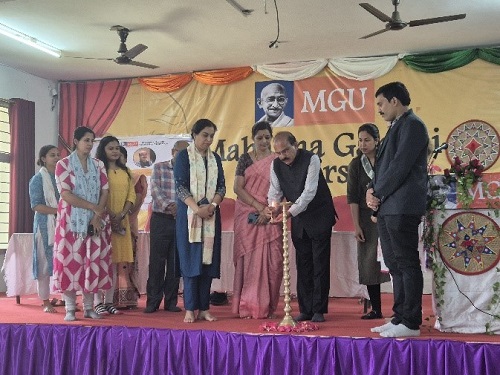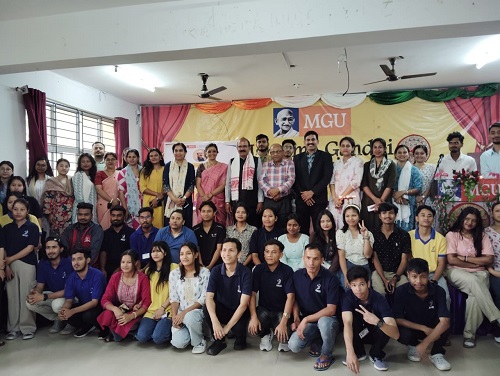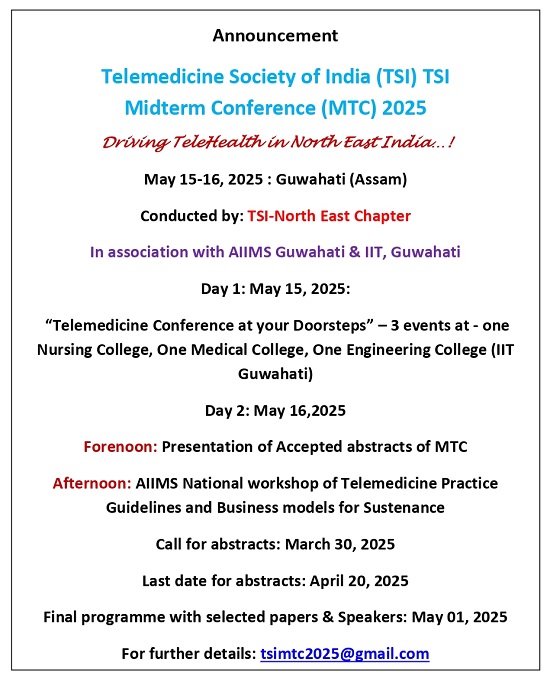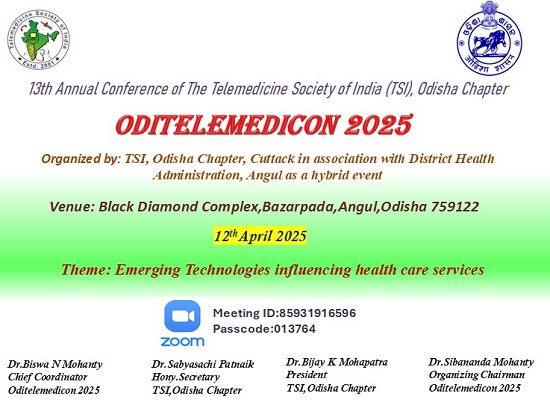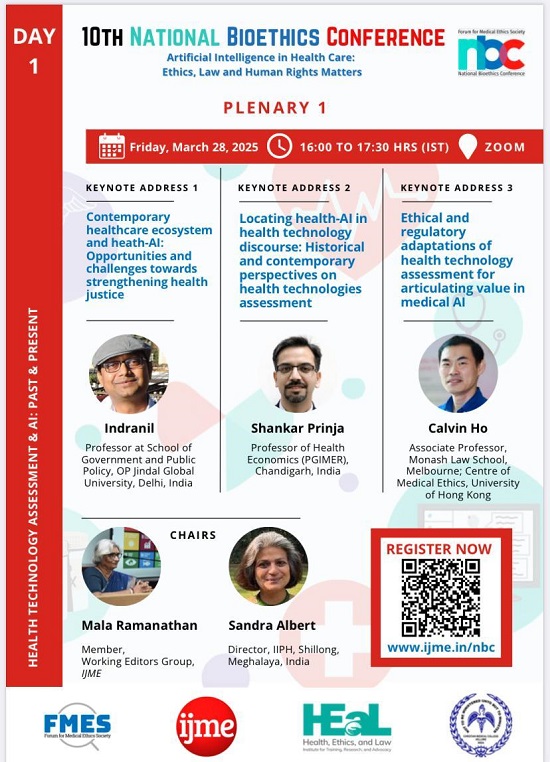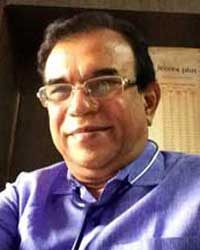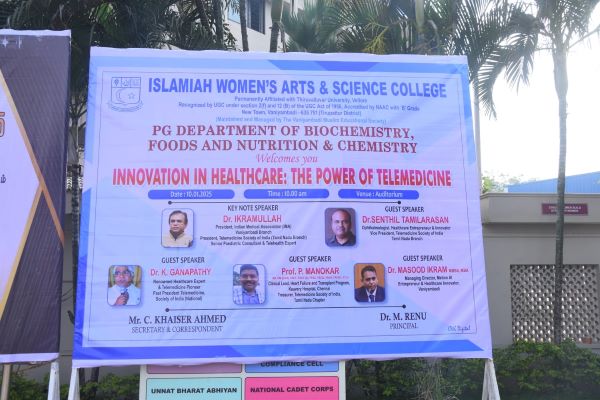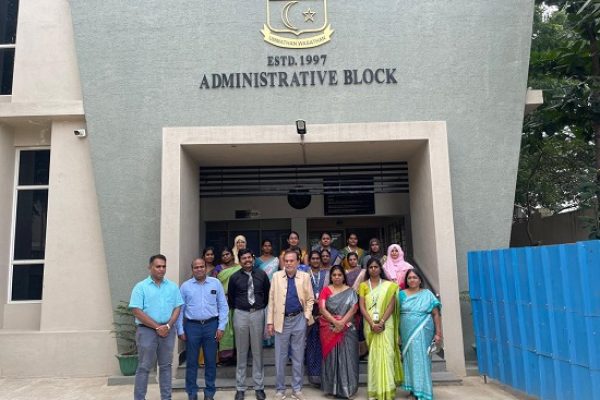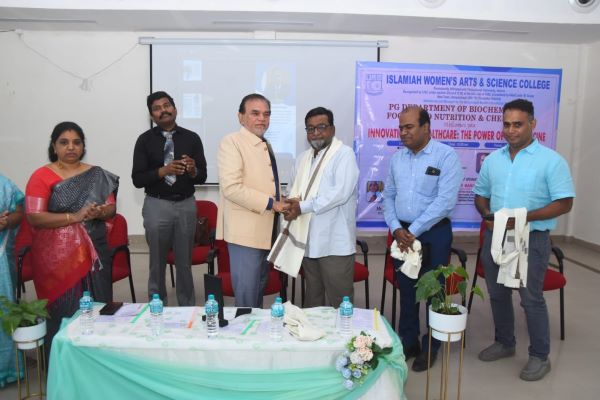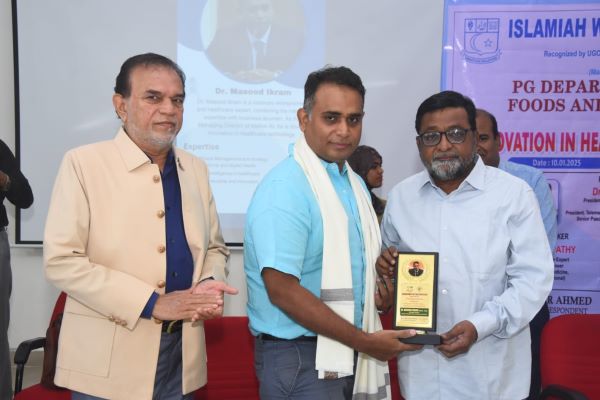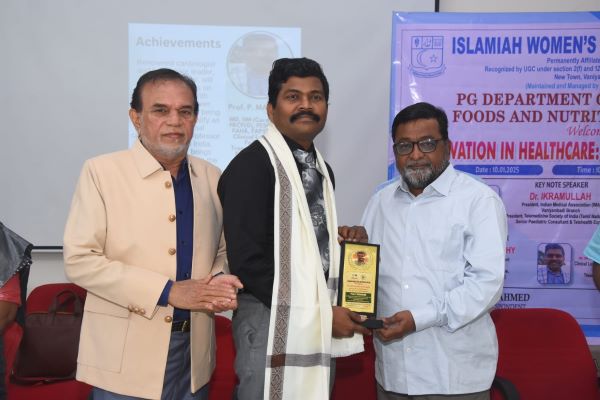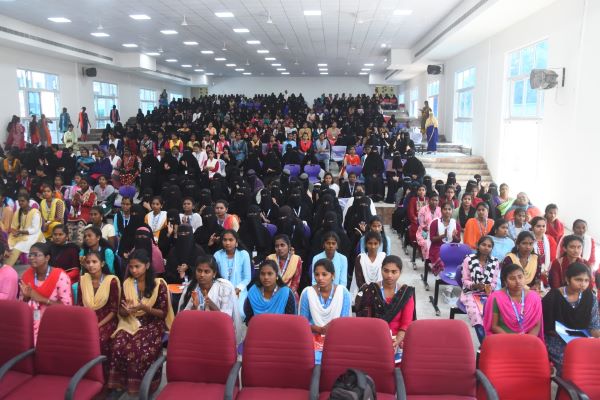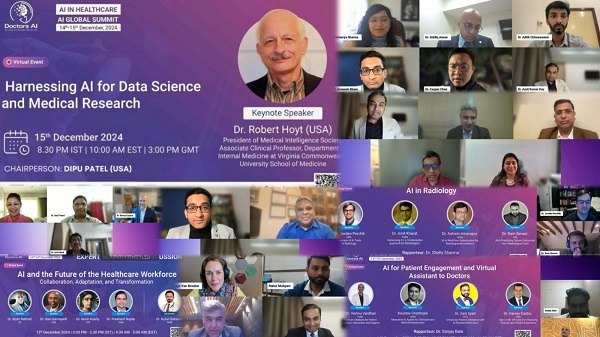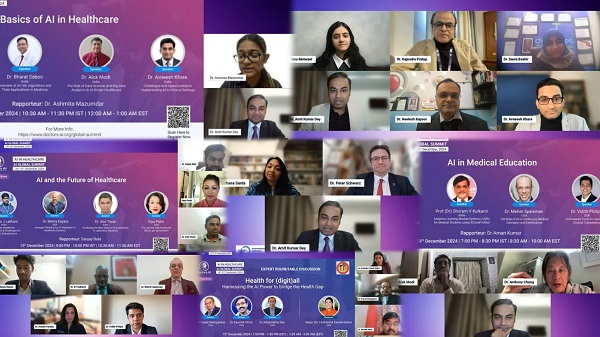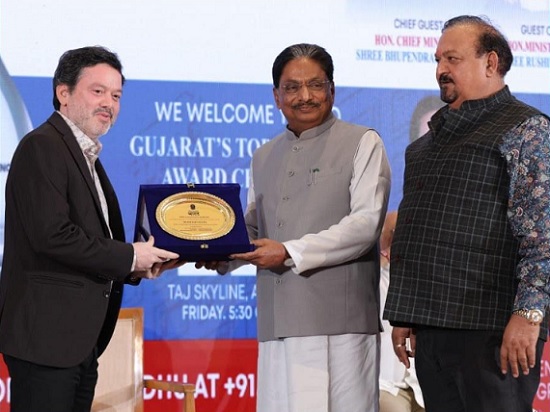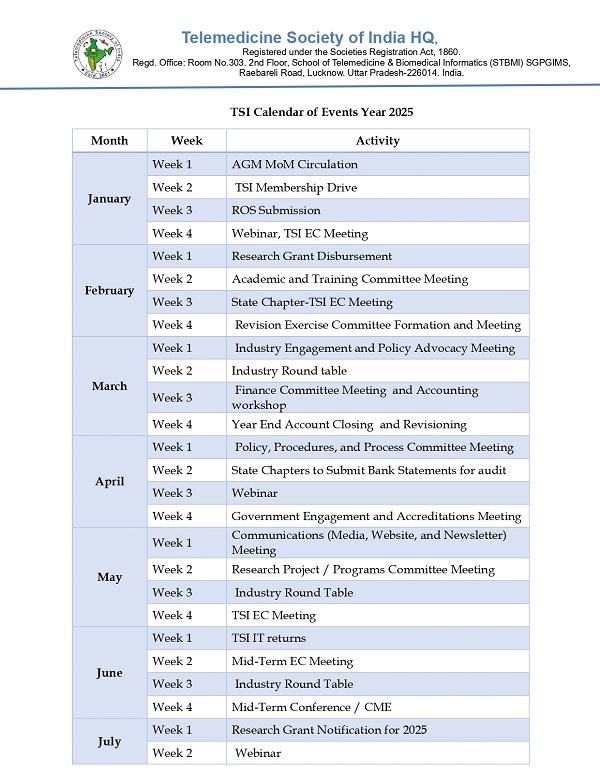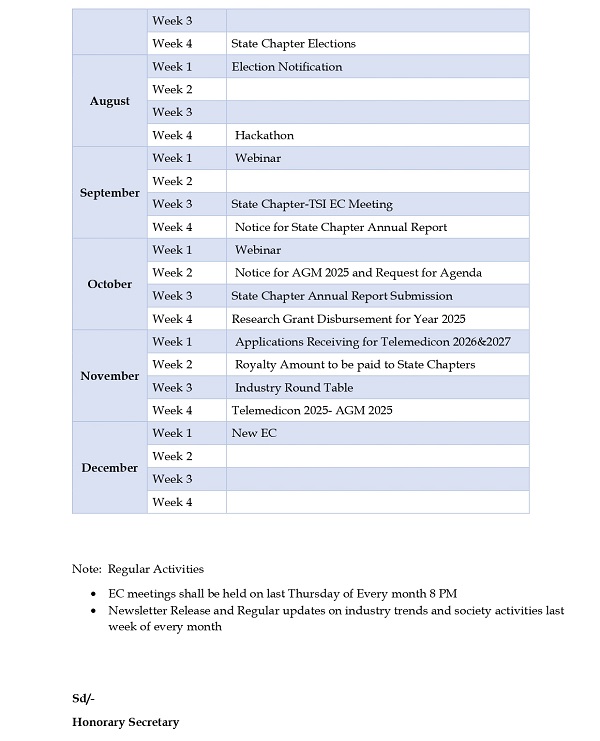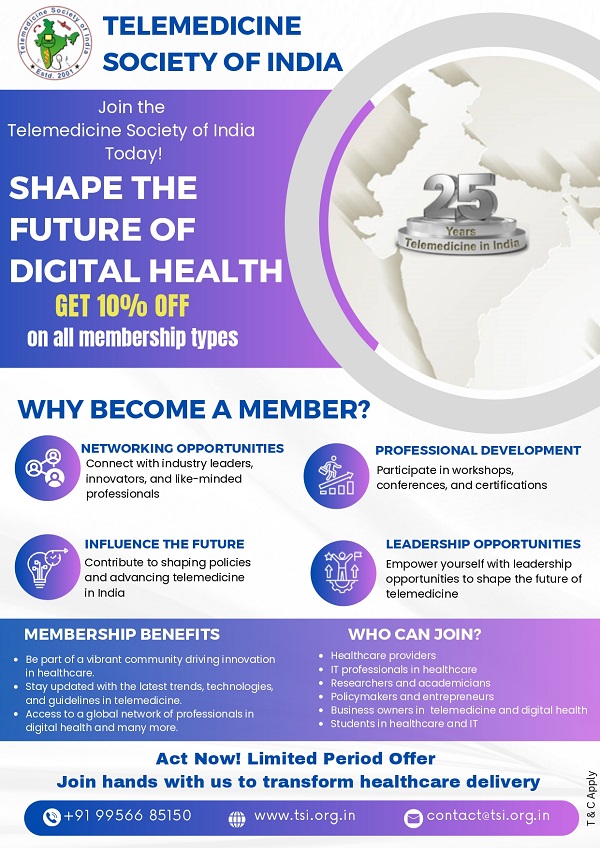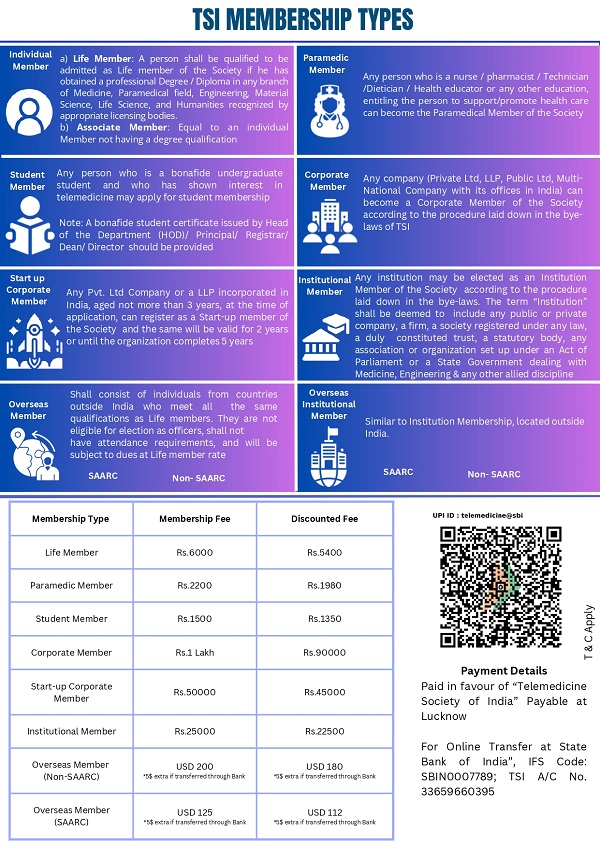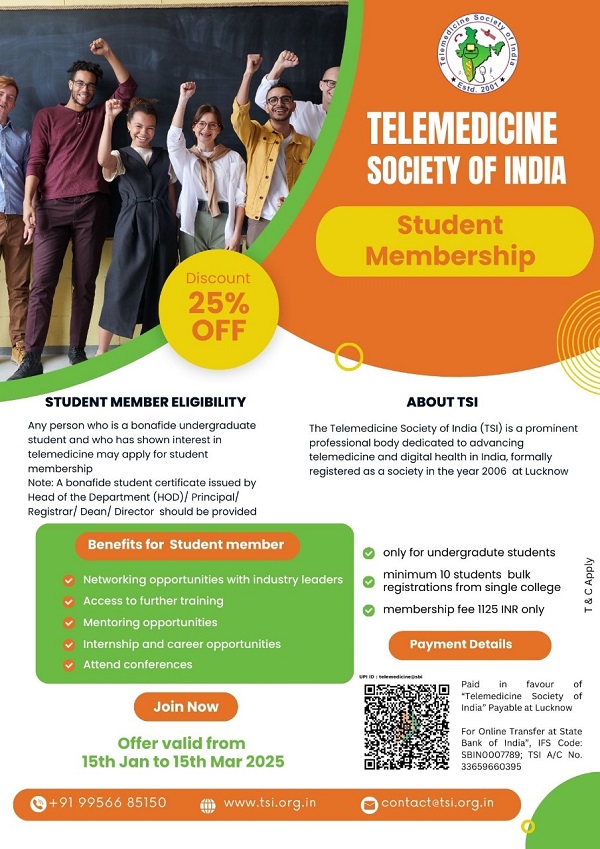Telehealth Newsletter
Official Newsletter of Telemedicine Society of India

What is New?
We are gearing up for our annual conference – TELEMEDICON 2025, to be held next month at the Indian Institute of Science, Bangalore. This flagship event continues to blend academics, fellowship, networking, and shared goals in digital health – while also symbolically passing the baton to a new set of leaders.
However, this year’s election process has raised some concerns. Despite having an electronic voting system in place, there was limited enthusiasm among members to contest for executive committee positions – with fewer than four nominations for seven posts received. For a society of 1,600 members and 20 state chapters, this trend calls for serious introspection.
This issue features some insightful articles including AI Curtain Raiser Summit at IIM Ahmedabad, offering a glimpse into the upcoming AI Impact Summit scheduled for February 2026 in Delhi.
We look forward to meeting all of you at TELEMEDICON 2025!
Thank You
Dr. Sunil Shroff
Chief Editor
President-Elect, TSI

An Ingenious AI Discovery in Antibiotics for Crohn’s Disease
Manjubashini
M.Sc (Bio-Informatics)
Content Writer, Medindia.net
A novel antibiotic drug, enterololin, can attack a definite group of disease-causing bacteria including the strains of E.coli that navigate Crohn’s disease. At present, as there is no cure available for inflammatory bowel diseases (IBD), this latest drug offers a promising treatment option.
An innovative AI tool could predict the drug’s mode of attack on the specific protein complex called LolCDE, representing a significant milestone in IBD drug design. The discoveries were made by researchers at McMaster University and the Massachusetts Institute of Technology (MIT), published in journal Nature Microbiology.
The discovery unveils a promising new treatment option for millions of people affected by Crohn’s disease and other related conditions, while also showcasing important new applications for AI in drug discovery research.
New Antibiotic Attacks Enterobacteriaceae While Preserving Good Bacteria
“This work shows that we’re still just scratching the surface as far as AI-guided drug discovery goes,” says Jon Stokes, an assistant professor in McMaster’s Department of Biochemistry and Biomedical Sciences and principal investigator on the new study.
“The development of our new drug, which is designed to target IBD, has been fast-tracked thanks to the collaboration between humans and generative AI.” Most antibiotics used in clinics today are “broad-spectrum” drugs, meaning they wipe out good bacteria in addition to those that cause disease — “they’re nukes,” Stokes explains. This can create opportunities for invasive and drug-resistant species of bacteria, like E. coli, to move in and colonize the intestines, which can exacerbate conditions like Crohn’s.
But enterololin, the new antibiotic discovered at McMaster, is a “narrow-spectrum” drug, meaning it spares the microbiome and attacks only a specific group of disease-causing bugs — in this case, a family of bacteria called Enterobacteriaceae, which happens to include E. coli. This means it not only kills E. coli, but also reduces the opportunity for drug-resistant strains to colonize the gut in the first place.
AI Predicts Drug Mechanism of Action (MOA) for the First Time
“This new drug is a really promising treatment candidate for the millions of patients living with IBD,” Stokes says. “We currently have no cure for these conditions, so developing something that might meaningfully alleviate symptoms could help people experience a much higher quality of life.”
To date, AI has been leveraged as a tool for predicting which molecules might have therapeutic potential, but this study used it to describe what researchers call “mechanism of action” (MOA) — or how drugs attack disease.
“AI has expedited the rate at which we can explore chemical space for new drug candidates, but, until now, it has done little to alleviate a major bottleneck in drug development, which is understanding what these new drug candidates actually do,” explains Stokes.
AI Pinpoints Enterololin’s Attack on the Target Protein
MOA studies, he says, are essential for drug development. They help scientists confirm safety, optimize dosage, make modifications to improve efficacy, and sometimes even uncover entirely new drug targets. They also help regulators determine whether or not a given drug candidate is suitable for use in humans. But they’re also notoriously expensive — and slow.
Stokes says a thorough MOA study can take up to two years and cost around $2 million; however, using AI, his group did enterololin’s in just six months and for just $60,000.
Indeed, after his lab’s discovery of the new antibiotic, Stokes connected with colleagues at MIT’s Computer Science and Artificial Intelligence Lab (CSAIL) to see if any of their emerging machine learning platforms could help fast-track his upcoming MOA studies.
In just 100 seconds, he was given a prediction: his new drug attacked a microscopic protein complex called LolCDE, which is essential to the survival of certain bacteria.
“A lot of AI use in drug discovery has been about searching chemical space, identifying new molecules that might be active,” says Regina Barzilay, a professor in MIT’s School of Engineering and the developer of DiffDock, the AI model that made the prediction.
Empirical Evidence Proves AI’s Important Prediction
“What we’re showing here is that AI can also provide mechanistic explanations, which are critical for moving a molecule through the development pipeline.” Barzilay was recently listed among Time Magazine’s most influential people in AI. Stokes stresses that while the prediction was intriguing, it was just that — a prediction. He would still have to conduct traditional MOA studies in the lab.
“Currently, we can’t just assume that these AI models are totally right, but the notion that it could be right took the guesswork out of our next steps,” explains Stokes, a member of the Michael G. DeGroote Institute for Infectious Disease Research at McMaster.
And so his team, led in large part by McMaster graduate student Denise Catacutan, began investigating enterololin’s MOA, using MIT’s prediction as a starting point. Within just a few months, it became clear that the AI was in fact right.
AI as a Tool for Fixing Drug Resistance Problem
“We did all of our standard MOA workup to validate the prediction — to see if the experiments would back-up the AI, and they did,” says Catacutan, a PhD candidate in the Stokes Lab. “Doing it this way shaved a year-and-a-half off of our normal timeline.”
With this, Stokes has now successfully used AI to discover viable drug candidates, to fast-track global drug discovery efforts, and to determine how new drugs work. But, ask him, and he’ll tell you that — beneficial as it is — AI is merely a means to an end.
“Drug resistance and our lack of new drugs is a leaky faucet,” he says. “You can leave it be for a while, but you’re eventually going to have a big problem. AI is my wrench — it’s a tool for fixing the leak before it becomes a flood, and that’s really it. My sole focus is on getting new drugs to the patients who need them, and as long as AI can help me do that, then I’ll continue to find new ways to use it.”
Testing Enterololin Against Other Drug-Resistant Bacteria
The pathway to patients Stokes’ spin-out company, Stoked Bio, has already licensed enterololin from McMaster and is currently optimizing it for human use.
The company is also testing modified versions of the new antibiotic against other drug-resistant bacteria, like Klebsiella, and early results are promising.
“The identification of enterololin underscores the remarkable science emerging at McMaster,” says Jeff Skinner, CEO at Stoked Bio. “We are proud to partner with the university on translating this breakthrough into real therapies for patients.”
If all goes well, Stokes says that the new drug will be ready for human trials within three years — a timeline his research team is eager to meet. “Working on something translational like this is surreal,” says Catacutan. “The fact that something we discovered in the lab may someday help patients is truly amazing, and really reinforces the significance of our work.”

Conference on Responsible AI Innovation in Healthcare: A Collaboration between IIM Ahmedabad and CoRE-AI
Meemansa Agarwal
Programme Manager, The Dialogue
A two-day conference held on 9th and 10th October, organized jointly by the Centre for Management of Health Services (IIM Ahmedabad) and CoRE-AI (Coalition for the Responsible Evolution of AI), served as a pre-summit event leading up to the AI Impact Summit 2026.
The event brought together clinicians, healthcare providers, academics, and technologists who are developing cutting-edge AI solutions in healthcare. Participants explored synergies between clinical and technological expertise and discussed strategies to accelerate AI adoption in the healthcare sector.
The conference featured four panel discussions on topics including:
The current landscape of AI adoption in India’s healthcare ecosystem and successful use cases.
Barriers preventing AI tools from scaling beyond pilot projects into mainstream clinical practice.
Building the digital infrastructure and leadership capacity required for effective AI integration.
Ensuring equitable access to quality care through responsible AI deployment across rural and urban contexts.
Challenges around data procurement for AI innovation and the role of interoperability and data-sharing standards in scaling AI solutions.
Promoting ethical and responsible AI practices in healthcare.
Additionally, a roundtable discussion brought together clinicians and innovators to explore how both communities can collaborate more effectively. Clinicians voiced concerns over the lack of collaboration, noting that AI development is often concentrated in certain specialties and tends to replace rather than augment clinical expertise. They also highlighted challenges related to bureaucratic hurdles in procuring data and securing support from clinicians, as well as the limited funding for long-gestation projects, which slows meaningful AI development and adoption. The discussion focused on strategies to foster user-centered design, co-development, and responsible adoption of AI in healthcare, aiming to bridge the communication gap between innovators and clinicians.
About the AI Impact Summit 2026:
Hosted by the Ministry of Electronics and Information Technology, the India AI-Impact Summit 2026 will take place on 19–20 February 2026 in New Delhi. The Summit serves as a global platform to highlight AI’s transformative potential in driving inclusive development, sustainability, and equitable progress. It envisions a future where AI advances human well-being, promotes social development, fosters innovation, and safeguards the planet.
The Three Sutras
The Summit will be guided by three core principles:
People: AI should serve all of humanity, respecting diversity, cultural identities, and human dignity, ensuring that no one is left behind. Focus areas include human development in an AI-enabled world, multilingual and accessible systems, and safe, trustworthy deployment.
Planet: AI development and deployment must be resource-efficient and aligned with climate resilience, environmental protection, and scientific advancement, supporting global sustainability and planetary stewardship.
Progress: AI’s benefits should be equitably distributed, with democratized access to datasets, computing power, and models. Applications span critical sectors such as healthcare, education, governance, and agriculture, ensuring that AI drives meaningful societal impact.

From Catheter to Calm: VR Transforms Patient Experience in Heart Care
Colleen Fleiss
M.SC (Bioinformatics)
Content Writer, Medindia.net
Patients undergoing coronary angiography—a procedure often performed while the patient is awake—frequently experience anxiety, typically managed with anti-anxiety medications.
VR in Cardiology
However, a new analysis presented at the American College of Cardiology (ACC) Middle East 2025, together with the 16th Emirates Cardiac Society Conference, found that virtual reality (VR) can effectively reduce anxiety and stabilize vital signs during the procedure, offering a promising alternative to traditional approaches.
“Virtual reality offers an innovative solution to manage and reduce the anxiety of patients undergoing an interventional cardiovascular procedure, like coronary angiography,” said Yousef Radwan Alnomani, a clinical researcher at Benha University in Egypt and lead author of the study. Coronary angiography is a type of cardiac catheterization that uses catheters and X-rays to detect narrowed or blocked vessels and, if necessary, place stents in the heart’s arteries.
VR’s Effectiveness During Coronary Angiography to Stabilize Vitals
Researchers conducted a meta-analysis of five randomized controlled trials involving 451 patients, comparing VR to standard care. The VR interventions featured immersive 3D environments such as waterfalls, mountains, and valleys, designed to promote relaxation. The study found that VR during coronary angiography significantly reduced anxiety and minimized fluctuations in heart rate and blood pressure compared with standard care. In contrast, VR used only before the procedure reduced anxiety but did not significantly stabilize vital signs.
“Immersing patients in a 3D simulation offers better relaxation than simply watching a similar video on a screen,” Alnomani explained.
While the findings are promising, the study is limited by its retrospective nature, and the researchers emphasize the need for larger, randomized controlled trials to confirm VR’s effectiveness and explore its broader use in cardiovascular procedures.
This research underscores the potential of virtual reality to enhance patient experience, reduce procedural anxiety, and improve overall cardiovascular care.

Nanomaterial That Stimulates Brain Cells, Without Surgery Created
Dr. Shanmathi Rajendran
BDS
Content Writer, Medindia.net
Indian researchers at the Institute of Nano Science and Technology (INST) under the Department of Science and Technology (DST) have come up with a special nanomaterial that stimulates brain cells, without surgery, electrodes, or external devices!
It is a material known as graphitic carbon nitride (g-C₃N₄) and is a smart, biocompatible switch. It reacts to the natural electrical impulses of the brain, which assist the neurons to grow, connect, and work more efficiently.
Healing the Brain Naturally?
Deep Brain Stimulation (DBS) and other similar treatments typically involve the invasive and dangerous implantation of electrodes into the brain. However, g-C₃N₄ functions in a different way. By responding to the active and resting states of neurones, the substance functions as a smart switch, establishing the ideal environment for normal brain activity.
Steps Behind the Stimulation
Cultured Neurons:
Scientists grow brain cells (neurons) in a dish to study how they react to stimulation.
Stimulus and Membrane Potential:
Neurons naturally send tiny electrical signals — shown here as a spike in the red line (membrane potential).Creation of an Electric Field:
These voltage changes in the neurons generate an electromagnetic field.Role of g-C₃N₄ (the Smart Nanomaterial):
The semiconducting material detects and responds to this natural electric field..
When the neuron is at a resting position, it becomes conductive (active), which assists in sending subtle signals to the cells.
Neuronal Response:
The electric field generated by g-C₃N₄ triggers the opening of calcium ion (Ca²⁺) channels in the neuron membrane, known as Voltage-Gated Calcium Channels (VGCCs).Calcium Influx Promotes Better Communication:
The opening of these calcium pores increases the growth of neurons, their connections and communication, which resembles the signaling of the brain itself.
All this happens without implants, magnets, or electrodes — just by placing the nanomaterial near neurons. In laboratory tests, the nanomaterial even enhanced the dopamine formation (which is a major chemical in movement and mood control) and decreased toxic proteins associated with Parkinson’s disease in animal testing.
Can ON-OFF Like Neurons!
Researchers found that the material’s behavior changes with the brain’s voltage signals:
In a resting state (−90 mV), the material turns “ON”, gently activating neurons.
In an active state (+55 mV), it switches “OFF”, preventing overstimulation.
The brain’s natural ability to rest when not needed and stimulate when needed is better reflected by this intelligent ON-OFF response. This keeps the brain functioning in a healthy way!
From Brain Healing to Brain Computing
This finding could support modern innovations like “brainware computing” in addition to curing illnesses like Parkinson’s and Alzheimer’s.
Brain organoids are tiny lab-grown brain tissues that scientists are testing as biological processors. They could open the door to bio-inspired computers that learn and think more like the human brain when combined with smart semiconductors like g-C3N4
A Step Toward Non-Invasive Brain Therapy
“This is the first demonstration of semiconducting nanomaterials directly modulating neurons without external stimulation,” said Dr. Manish Singh, who led the study.
The INST team made the point that, prior to human applications, further preclinical and clinical research is required.
“We believe this marks a paradigm shift in neuromodulation research. “From treating brain injuries to managing neurodegeneration, semiconducting nanomaterials hold immense promise for the future,” Dr Singh added.
The research, published in ACS Applied Materials & Interfaces, marks a paradigm shift in neuromodulation—offering a safer, simpler, and smarter path to treat brain disorders. Scientists believe this nanotech breakthrough could redefine brain medicine and computing in the years to come.
The Future of Brain Healing Lies Not in Wires, But With Smarter Materials that Thinks Like Your Brain!

Toxic E-Waste Linked to High Blood Pressure in Kids
Dr. Nikitha Narayanan
MDS
Content Writer, Medindia.net
Children living near electronic waste (e-waste) recycling sites may be facing more than just pollution — they’re also at risk of developing high blood pressure, a condition once rare in the young.
A new study published in Environment & Health reveals that children exposed to harmful metals and volatile chemicals from e-waste dumps were about four times more likely to develop hypertension than those in other regions (12.7% vs. 3.1%).
How E-Waste Pollution Affects the Body
E-waste — discarded computers, phones, and other electronics, often release toxic metals like lead, arsenic, and cadmium, along with volatile organic compounds (VOCs) such as benzene and styrene, when dismantled or burned.
These substances can enter the bloodstream and alter key metabolic pathways, especially those linked to the gut and cardiovascular system. The result? Disrupted blood pressure regulation and early signs of hypertension in children.
Inside the Study
The research involved 426 children from an e-waste recycling region in China. Scientists analyzed urine samples to measure 18 metal(loid)s and 15 VOC metabolites, along with over 180 metabolic markers using advanced techniques. Children’s blood pressure was measured following standard pediatric guidelines. Statistical models and machine learning analysis showed that exposure to certain metal(loid)s — including cobalt, gallium, and tin — and VOCs was strongly associated with elevated blood pressure.
The Hidden Role of the Gut
One of the study’s most striking findings was the link between pollution and the gut’s metabolic activity.
Changes in metabolites such as l-glutamine and N-phenylacetyl-l-glutamine (PAGln) suggest that gut bacteria may play a role in how the body responds to toxic exposure. Pollutants may disrupt gut microbiota, triggering oxidative stress and hormonal imbalances, which over time could raise blood pressure.
Future Implications
This research sheds light on an emerging public health threat. As global e-waste continues to rise, millions of children in low-income regions may face similar risks.
Experts stress the need for safer recycling practices, strict pollution controls, and regular health monitoring for children in affected areas.
The study also opens new doors for early detection and prevention, using metabolomic profiling to identify at-risk children before hypertension becomes irreversible.
::ANNOUNCEMENTS::
::CROSSWORD::
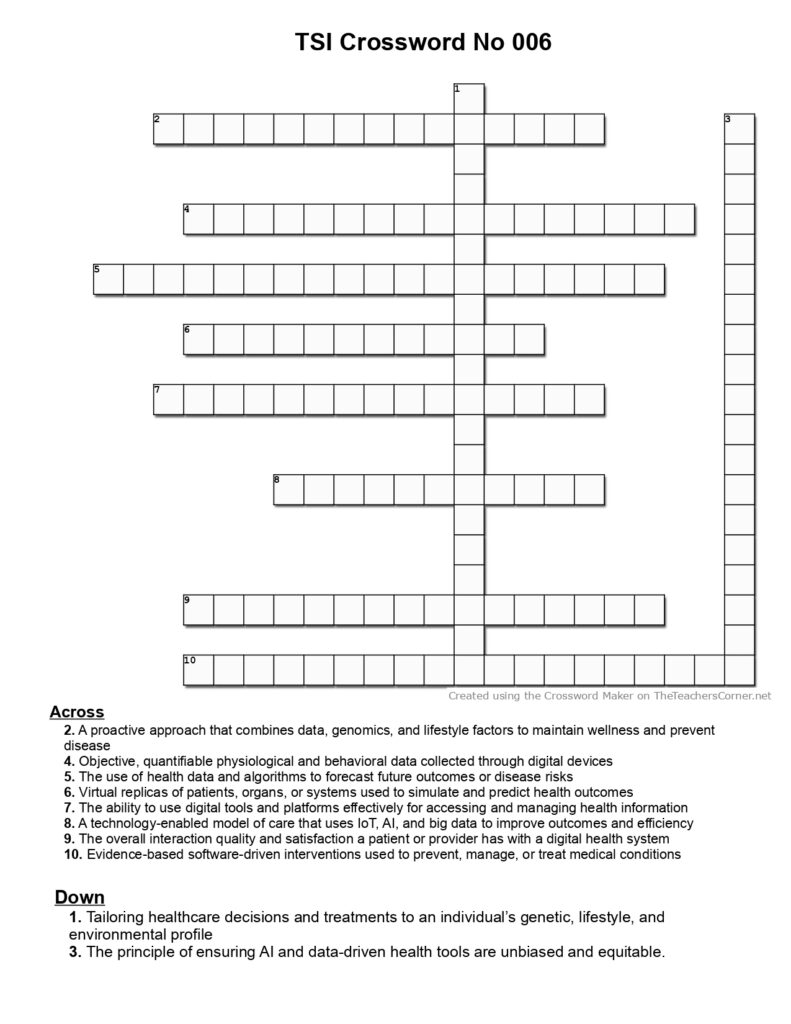
Click here to Print the Crossword
Click here to view the Crossword Rules and Regulations
Compiled by Dr.Umashankar
Answers in November2025 Newsletter!
Telemedicine – News from India & Abroad
IndiaAI & WHO Seek Scalable AI Health Innovations
Explore how AI is transforming healthcare, from diagnostics and patient care to operational efficiency and personalized medicine…………. Read More
AI’s New Lookup Trick Beats Medical Coding Errors
A simple AI coding upgrade boosts accuracy, cuts errors, saves time — and may even outperform doctors…………….. Read More
AI Reveals the Hidden Architecture of Embryo Growth
AI can create realistic embryoid images to study human embryo development objectively under varying conditions…………… Read More
Telemedicine Practice Guidelines – A Foundation Course for RMPs by TSI Faculty
To know more about the Telemedicine Foundation Course click on the link below:
https://tsitn.org/tpg-course/
Medical Writing Certificate Course with Internship Opportunity!
TSI invites all the TSI Chapters and Members to submit information on their upcoming Webinar or Events (50 words), News related to Telemedicine (200 words) or short articles (500 words) for the monthly e-newsletter.Guidelines for submission to TSI Newsletter-
- Report can be from 500 to 600 words
- Report Should be relevant to Telemedicine or Medical Informatics
- No promotion of self or any product
- Avoid plagiarism
- All references should be included
- Provide any attributions
- Visuals are welcome including video links
- Send full authors name, degrees, affiliations along with a passport sized photograph of good resolution. If multiple authors only main author photo to be sent.
Submission may be sent to – tsigrouptn@gmail.com
Editors reserve the rights for accepting and publishing any submitted material.
Editor in Chief – Dr. Sunil Shroff
Editors – Dr. Senthil Tamilarasan & Dr. Sheila John
Technical Partner- https://www.medindia.net


